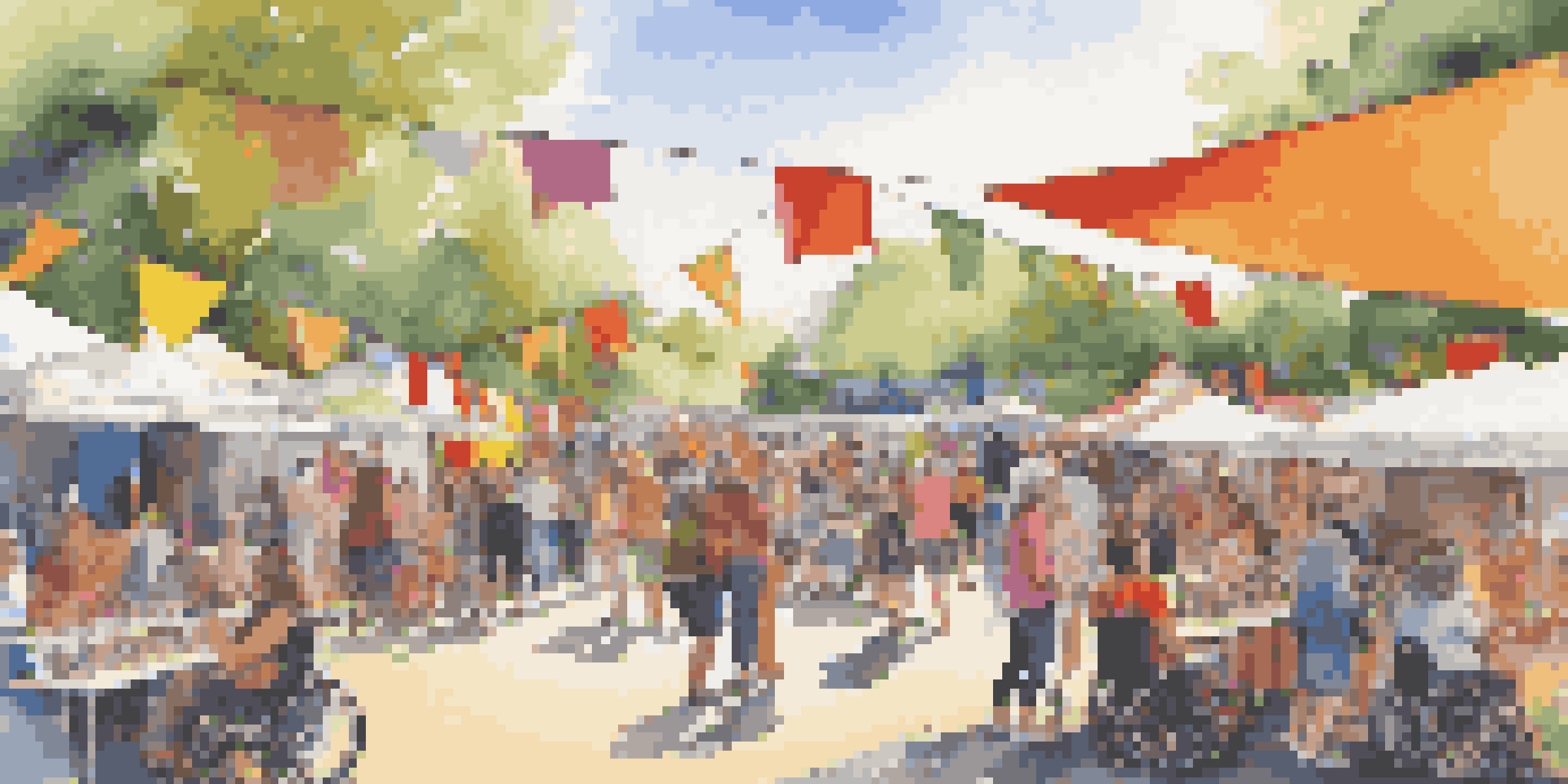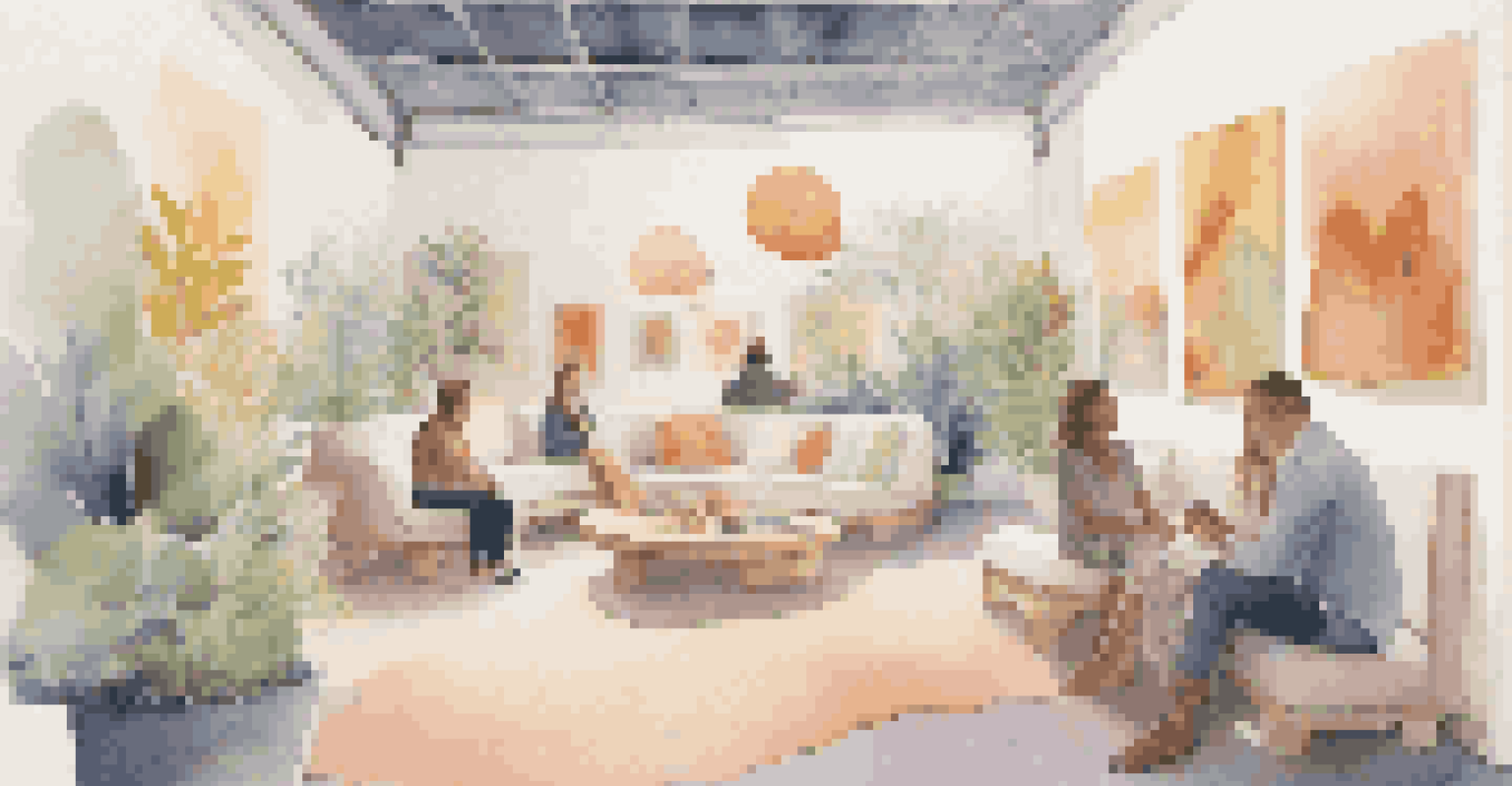Art Festivals: Making Events More Accessible

Understanding Accessibility in Art Festivals
Accessibility in art festivals means creating an environment where everyone can enjoy and participate in the festivities. It goes beyond just physical access; it encompasses sensory experiences, communication, and inclusive programming. When we think about accessibility, we must consider the diverse needs of all attendees, including those with disabilities, the elderly, and families with young children.
Accessibility is not about disability; it's about the design of all of our communities.
Imagine a festival where a person in a wheelchair can easily navigate the grounds, or where someone with hearing impairment can fully engage with the art through visual aids. This vision of inclusivity not only enriches the experience for individuals but also fosters a sense of community and belonging. By prioritizing accessibility, art festivals can open their doors to a broader audience.
Moreover, implementing accessible features often leads to creative solutions that enhance the overall festival experience for everyone. For example, providing multi-sensory art installations can engage visitors in unique ways, making the event memorable and enjoyable.
Physical Accessibility: Key Considerations
When organizing art festivals, physical accessibility is a primary concern that directly impacts attendance. This includes ensuring that venues are wheelchair-friendly, with ramps, elevators, and accessible restrooms. Additionally, pathways should be wide and clear, allowing everyone to move freely without obstacles.

Consider the layout of the festival space: it’s crucial to create a design that minimizes congestion and allows for easy navigation. Designated seating areas can also provide comfort for those who may need to rest or require a quieter space amidst the hustle and bustle. Planning such elements can significantly enhance the festival experience for all attendees.
Accessibility Enhances Festival Enjoyment
Creating an inclusive environment at art festivals allows all attendees, including those with disabilities, to fully engage and enjoy the experience.
Furthermore, providing accessible parking and transportation options can make a world of difference. Festivals that prioritize access from arrival to departure set a positive tone, allowing guests to focus on enjoying the art rather than worrying about logistics.
Sensory-Friendly Options for Diverse Audiences
Art festivals can be sensory-rich environments, which is wonderful for many but overwhelming for others, particularly those on the autism spectrum or with sensory sensitivities. To cater to these needs, festivals can offer sensory-friendly spaces where visitors can retreat if they feel overwhelmed. These areas can be equipped with calming elements like soft lighting and soothing sounds.
Art is not a thing; it is a way.
In addition to creating quiet zones, offering sensory-friendly programming is essential. This might include interactive art workshops where participants can engage at their own pace or guided tours that emphasize visual storytelling without overwhelming stimuli. By providing these options, festivals can ensure a welcoming atmosphere for everyone.
Moreover, clear communication about sensory-friendly details in promotional materials can help potential attendees prepare for their experience. This proactive approach shows that the festival values inclusivity and encourages a diverse audience to attend.
Inclusive Programming: Engaging All Attendees
Inclusive programming is vital for making art festivals accessible and enjoyable for everyone. This involves curating a variety of activities that cater to different interests and abilities. From workshops focused on different artistic techniques to performances that highlight diverse cultures, there’s something for everyone.
Consider incorporating sign language interpreters for performances and presentations, which not only helps those with hearing impairments but enriches the experience for all. Additionally, offering materials in multiple languages can help non-native speakers feel more included and engaged with the festival's offerings.
Community Involvement Fuels Success
Collaborating with local organizations and artists enriches festival programming and ensures accessibility efforts meet the diverse needs of the community.
Furthermore, involving community members in programming decisions can lead to more relevant and relatable content. By listening to the voices of those they aim to serve, festival organizers can create experiences that resonate and inspire.
Technology: Enhancing Accessibility Through Innovation
In today's digital age, technology plays a crucial role in enhancing accessibility at art festivals. Mobile applications can provide real-time information about event schedules, map accessibility features, and offer audio descriptions of artworks. These tools empower attendees to navigate the festival with ease and confidence.
Additionally, virtual reality (VR) experiences can bridge the gap for those unable to attend in person. Offering a virtual tour of the festival allows a wider audience to experience the art and culture from anywhere in the world. This not only expands access but also creates an opportunity for global engagement.
Moreover, utilizing social media platforms to share updates and accessibility features can foster a more inclusive community. By keeping everyone informed, festivals can encourage participation and make all attendees feel valued.
Community Involvement: Collaborating for Success
Engaging with the local community is essential for creating accessible art festivals. Collaborating with organizations that focus on disability advocacy and inclusion can provide valuable insights into the needs of diverse attendees. These partnerships can help shape the festival's accessibility efforts and ensure they are effective.
Moreover, involving local artists and performers from underrepresented communities can enrich the festival’s programming and attract a wider audience. By showcasing a variety of voices and perspectives, festivals can create a vibrant tapestry of culture that resonates with all attendees.
Technology Bridges Accessibility Gaps
Innovative tools like mobile apps and virtual reality enhance accessibility, empowering attendees to navigate and experience art festivals more easily.
Additionally, volunteer training on accessibility best practices can ensure that staff and volunteers are prepared to assist attendees effectively. A knowledgeable team can make a significant difference in creating an inclusive atmosphere, helping everyone feel welcome and supported.
The Impact of Accessible Art Festivals on Society
Accessible art festivals have a profound impact on society by fostering inclusivity and creativity. When art is accessible, it allows individuals from all walks of life to share their stories and experiences, enriching the cultural landscape. This, in turn, promotes understanding and empathy among diverse groups.
Furthermore, these festivals can serve as a platform for social change, raising awareness about accessibility issues and advocating for greater inclusivity in all areas of life. As more festivals adopt accessible practices, they inspire others to follow suit, creating a ripple effect that can lead to lasting change.

Ultimately, the commitment to accessibility in art festivals reflects a broader societal value: the belief that art should be a shared experience for everyone. By prioritizing inclusivity, festivals not only enhance their own events but also contribute to a more equitable and vibrant community.